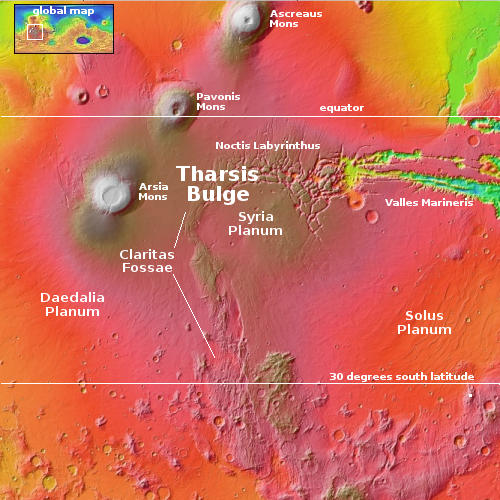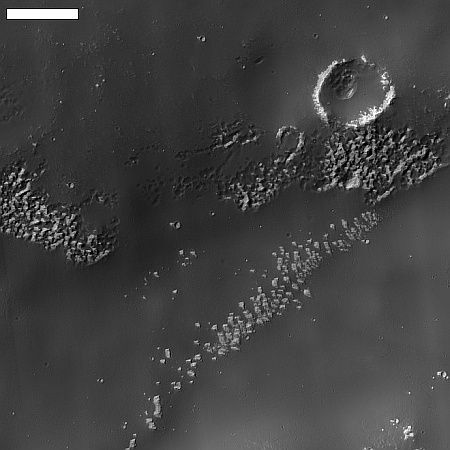Bright material on the high points of a Martian mountain
Today’s cool image is mostly an example of the present unknowns of Mars. The picture to the right, cropped, reduced, and sharpened to post here, was taken on April 2, 2025 by the high resolution camera on Mars Reconnaissance Orbiter (MRO).
The science team quite rightly labels this vaguely as “bright materials,” referring to the bright rim of that crater as well as the scattered bright patches on the surrounding plain. This vagueness tells us that the scientists don’t have enough data yet to definitively identify this stuff, though they know it is distinctly unique because of its inexplicable bright albedo compared to everything around it.
That the crater rim (as well as all the crater rims in the full picture) exhibit this same brightness suggests this material was excavated from below when the impacts hit. The surrounding patches suggest that erosion has exposed this buried material at these points.

The white dot in the lower right of the overview map to the right marks the location, on top of a 3,000-foot-high mountain at the southeast end of the long mountain chain dubbed Claritis Fossae.
The formation of these mountains is related to the rise of the Tharsis Bulge and Mars’ giant volcanoes. In a process similar to the basin-and-chain geology found where I live in southern Arizona, that rise caused the ground to spread and crack, from which lava could spew to form this mountain chain.
The white material suggests mineralogy that might be useful to future Martian colonists. Global mineralogical maps produced by the orbiters indicate that this material may be what scientists call “hydrated minerals,” formed in conjunction with the presence of water. These minerals are also a sign of the presence of other valuable mineral resources, making this location a potential mining location.
On Christmas Eve 1968 three Americans became the first humans to visit another world. What they did to celebrate was unexpected and profound, and will be remembered throughout all human history. Genesis: the Story of Apollo 8, Robert Zimmerman's classic history of humanity's first journey to another world, tells that story, and it is now available as both an ebook and an audiobook, both with a foreword by Valerie Anders and a new introduction by Robert Zimmerman.
The print edition can be purchased at Amazon or from any other book seller. If you want an autographed copy the price is $60 for the hardback and $45 for the paperback, plus $8 shipping for each. Go here for purchasing details. The ebook is available everywhere for $5.99 (before discount) at amazon, or direct from my ebook publisher, ebookit. If you buy it from ebookit you don't support the big tech companies and the author gets a bigger cut much sooner.
The audiobook is also available at all these vendors, and is also free with a 30-day trial membership to Audible.
"Not simply about one mission, [Genesis] is also the history of America's quest for the moon... Zimmerman has done a masterful job of tying disparate events together into a solid account of one of America's greatest human triumphs."--San Antonio Express-News
Today’s cool image is mostly an example of the present unknowns of Mars. The picture to the right, cropped, reduced, and sharpened to post here, was taken on April 2, 2025 by the high resolution camera on Mars Reconnaissance Orbiter (MRO).
The science team quite rightly labels this vaguely as “bright materials,” referring to the bright rim of that crater as well as the scattered bright patches on the surrounding plain. This vagueness tells us that the scientists don’t have enough data yet to definitively identify this stuff, though they know it is distinctly unique because of its inexplicable bright albedo compared to everything around it.
That the crater rim (as well as all the crater rims in the full picture) exhibit this same brightness suggests this material was excavated from below when the impacts hit. The surrounding patches suggest that erosion has exposed this buried material at these points.

The white dot in the lower right of the overview map to the right marks the location, on top of a 3,000-foot-high mountain at the southeast end of the long mountain chain dubbed Claritis Fossae.
The formation of these mountains is related to the rise of the Tharsis Bulge and Mars’ giant volcanoes. In a process similar to the basin-and-chain geology found where I live in southern Arizona, that rise caused the ground to spread and crack, from which lava could spew to form this mountain chain.
The white material suggests mineralogy that might be useful to future Martian colonists. Global mineralogical maps produced by the orbiters indicate that this material may be what scientists call “hydrated minerals,” formed in conjunction with the presence of water. These minerals are also a sign of the presence of other valuable mineral resources, making this location a potential mining location.
On Christmas Eve 1968 three Americans became the first humans to visit another world. What they did to celebrate was unexpected and profound, and will be remembered throughout all human history. Genesis: the Story of Apollo 8, Robert Zimmerman's classic history of humanity's first journey to another world, tells that story, and it is now available as both an ebook and an audiobook, both with a foreword by Valerie Anders and a new introduction by Robert Zimmerman.
The print edition can be purchased at Amazon or from any other book seller. If you want an autographed copy the price is $60 for the hardback and $45 for the paperback, plus $8 shipping for each. Go here for purchasing details. The ebook is available everywhere for $5.99 (before discount) at amazon, or direct from my ebook publisher, ebookit. If you buy it from ebookit you don't support the big tech companies and the author gets a bigger cut much sooner.
The audiobook is also available at all these vendors, and is also free with a 30-day trial membership to Audible.
"Not simply about one mission, [Genesis] is also the history of America's quest for the moon... Zimmerman has done a masterful job of tying disparate events together into a solid account of one of America's greatest human triumphs."--San Antonio Express-News


